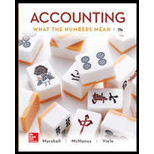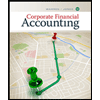
Accounting: What the Numbers Mean
11th Edition
ISBN: 9781259535314
Author: David Marshall, Wayne William McManus, Daniel Viele
Publisher: McGraw-Hill Education
expand_more
expand_more
format_list_bulleted
Textbook Question
Chapter 8, Problem 8.28P
Problem 8.28
LO 1, 2, 4, 6
Transaction analysis-various accounts Enter the following column headings across the top of a sheet of paper:
| Other | Paid-In | Retained | Treasury | Net |
| Transaction Cash Assets | Liabilities Capital | Earnings | Stock | Income |
Enter the transaction letter in the first column and show the effect (if any) of each of the following transactions on each financial statement category by entering a plus (+) or minus (-) sign and the amount in the appropriate column. Do not show items that affect net income in the
- Sold 2,700 shares of $50 par value
preferred stock at $53.50 per share. - Declared the annual cash dividend of $3.70 per share on common stock. There were 7,300 shares of $1 par value common stock issued and outstanding throughout the year.
- Issued 5,000 shares of $50 par value preferred stock in exchange for a building when the market price of preferred stock was $53 Per share.
- Purchased 1,400 shares of preferred stock for the treasury at a price of $56 per share.
- Sold 500 shares of the preferred stock held in treasury (see d) for $57 per share.
- Declared and issued a 15% stock dividend on the $1 par value common stock when the market price per share was $36.
Expert Solution & Answer
Want to see the full answer?
Check out a sample textbook solution
Students have asked these similar questions
20) On a bank's income statement, the amount available to keep as retained earnings or pay to the stockholders in dividends is the bank's A) net income. B) net operating income. C) net extraordinary items. D) net interest margin
Problem 19
When examining the accounts of Ayala Corporation, it is ascertained that balance relatingto both receivables and payables are included in a single controlling account called“Receivables control” that has a debit balance of P4,850,000. An analysis of the make-upof this account revealed the following:Debit Accounts receivable – customers 7,800,000Accounts receivable – officers 500,000Debit balances – creditors 300,000Postdated checks from customers 400,000Subscriptions receivable 800,000CreditAccounts payable for merchandise 4,500,000Credit balances in customer’s accounts 200,000Cash received in advance from customers 100,000Expected bad debts 150,000After further analysis of the aged accounts receivable, it is determined that the allowancefor doubtful accounts be P200,000. What is the correct total of current net receivables?__________.
29
Which financial statement provides the most information about the following topics (and why)?
Ability to pay debts
Sources of cash receipts
Issuance of common stock
Usage of cash
Amount the owners’ would receive if the firm closed
Payment of dividends (stock or cash)
Performance of the firm (in a given period)
Amount owed to a creditor
Chapter 8 Solutions
Accounting: What the Numbers Mean
Ch. 8 - Prob. 8.1MECh. 8 - Mini-Exercise 8.2 LO 2 Preferred stock-calculate...Ch. 8 - Prob. 8.3MECh. 8 - Mini-Exercise 8.4 LO 6 Treasury stock transactions...Ch. 8 - Prob. 8.5ECh. 8 - Exercise 8.6 Review exercise-calculate net income...Ch. 8 - Prob. 8.7ECh. 8 - Exercise 8.8 Review exercise-calculate retained...Ch. 8 - Prob. 8.9ECh. 8 - Prob. 8.10E
Ch. 8 - Prob. 8.11ECh. 8 - Prob. 8.12ECh. 8 - Prob. 8.13ECh. 8 - Prob. 8.14ECh. 8 - Exercise 8.15 LO 3 Dividend dates-market price...Ch. 8 - Exercise 8.16 LO 3 Ex-dividend date-market price...Ch. 8 - Prob. 8.17ECh. 8 - Prob. 8.18ECh. 8 - Prob. 8.19ECh. 8 - Prob. 8.20ECh. 8 - Prob. 8.21ECh. 8 - Prob. 8.22ECh. 8 - Prob. 8.23PCh. 8 - Prob. 8.24PCh. 8 - Prob. 8.25PCh. 8 - Prob. 8.26PCh. 8 - Prob. 8.27PCh. 8 - Problem 8.28 LO 1, 2, 4, 6 Transaction...Ch. 8 - Problem 8.29 LO 1, 2, 4, 6 Transaction...Ch. 8 - Problem 8.30 LO 1. 2, 4, 6 Transaction...Ch. 8 - Prob. 8.31PCh. 8 - Prob. 8.32PCh. 8 - Prob. 8.33CCh. 8 - Prob. 8.34CCh. 8 - Prob. 8.35CCh. 8 - Case 8.36 LO 1, 2, 7 Capstone analytical review of...
Knowledge Booster
Learn more about
Need a deep-dive on the concept behind this application? Look no further. Learn more about this topic, accounting and related others by exploring similar questions and additional content below.Similar questions
- Single-step income statement and balance sheet Selected accounts and related amounts for Kanpur Co. for the fiscal year ended June 30, 20Y7, are presented in Problem 5-5B. Instructions 1.Prepare a single-step income statement in the format shown in Exhibit 13. 2. Prepare a statement of stockholders' equity. Additional common stock of 7,300 was issued during the year ended June 30. 20Y7. 3. Prepare a balance sheet, assuming that the current portion of the note payable is 7,000. 4.Prepare closing entries as of June 30, 20Y7.arrow_forwardEntries for notes receivable The series of five transactions recorded in the following T accounts were related to a sale to a customer on account and the receipt of the amount owed. Briefly describe each transaction. Cash Notes Receivable (e) 76,500 (c) 75,000 (d) 75,000 Accounts Receivable Cost of Goods Sold (a) 75,000 (c) 75,000 (b) 45,000 (d) 75,400 (b) 75,400 Inventory Interest Revenue (b) 45,000 (d) 400 (e) 1,100 Sales (a) 75,000arrow_forward7. Please answer all questions and make answer clear.Thanks ill give thumbs up The stockholders' equity section of the corporate balance sheet is separated into paid-in capital and retained earnings. Select one: True False Under the direct write-off method, when a previously written-off account is recovered in the same accounting period, which of the following entries is required to reinstate the account? a. debit Accounts Receivable and credit Bad Debt Expense b. debit Cash and credit Bad Debt Expense c. debit Accounts Receivable and credit Cash d. debit Cash and credit Accounts Receivablearrow_forward
Recommended textbooks for you
 Corporate Financial AccountingAccountingISBN:9781337398169Author:Carl Warren, Jeff JonesPublisher:Cengage Learning
Corporate Financial AccountingAccountingISBN:9781337398169Author:Carl Warren, Jeff JonesPublisher:Cengage Learning AccountingAccountingISBN:9781337272094Author:WARREN, Carl S., Reeve, James M., Duchac, Jonathan E.Publisher:Cengage Learning,
AccountingAccountingISBN:9781337272094Author:WARREN, Carl S., Reeve, James M., Duchac, Jonathan E.Publisher:Cengage Learning,

Corporate Financial Accounting
Accounting
ISBN:9781337398169
Author:Carl Warren, Jeff Jones
Publisher:Cengage Learning

Accounting
Accounting
ISBN:9781337272094
Author:WARREN, Carl S., Reeve, James M., Duchac, Jonathan E.
Publisher:Cengage Learning,
Dividend explained; Author: The Finance Storyteller;https://www.youtube.com/watch?v=Wy7R-Gqfb6c;License: Standard Youtube License